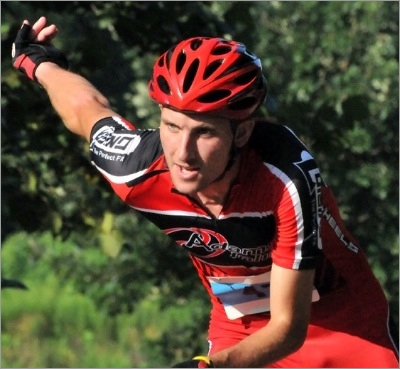 | ||
| ||||||||
By Ty Fidler
Ty Fidler on the racecourse photo: Daneen Colligan One thing that surprised me this year was how training alone — without training partners — affected my performance. I worried that it wouldn’t prepare me for the group dynamics of real-world racing. But my fears were unfounded. Rather than hurting me, training alone helped me focus on goals and gave me the ability to skate solo in races when necessary. Why Train Solo? During races, it’s tempting to tuck into a paceline and draft. Drafting requires less energy than skating alone — as much as 30 percent less. It also provides some companionship that helps stave off the loneliness and doubts of skating alone. But you’ll never win races or the respect of your fellow skaters if all you do is draft. This is especially true for someone like me. I’m not a top sprinter, so I can’t sit around in the pack and wait for the field sprint. I’ve got to try to breakaway — and if I get dropped, I’ve got to be able to skate alone. The ability to skate solo has allowed me to win races and salvage decent placements in others. In one race this year, I got dropped after five miles. It was a bad feeling. But I didn’t give up. Accustomed to skating alone, I kept rolling at a strong pace. Eventually, I hooked up with another dropped skater, and together we caught the lead pack and finished in the Top 10. In another race, I found myself in no-man’s land between two skaters I couldn’t catch and a chase pack full of sprinters. To earn a spot on the podium, I knew I had to stay well ahead of the chase pack. And thanks to my solo training, I was able to do that. Tips for Training Alone 1) Don't let your competitive nature sidetrack your training goals. One of my bad habits is trying to "compete" in practice, which more often than not involves chasing down cyclists. Competition is not a bad thing. But it can distract you from your training goals. If you're focused on keeping up with — or beating — your training partner (skater or cyclist), you may lose sight of your daily workout goals, like perfecting technique, completing your interval workout, or tapering for an event. 2) Lead as much as you can. When you are lucky enough to find a skater or cyclist to train with, don't spend too much time drafting. Lead as often as possible. When I train with others, I rarely draft. 3) Write a training schedule each week. Having a schedule gives you a goal to reach every time you skate and helps you avoid slacking, which is easy to do when you train alone. 4) Intensify your workouts on hard training days. When you train alone, it’s tough to practice at 100 percent. One way you can push yourself is to train wearing a weighted vest. It will make you work harder and you’ll feel like you’re flying when you take it off. 5) Set some competitive marks. There are a couple of guys in my hometown of St. Louis who "mark" every major object — tree, fire hydrant, parking lot — on the local trail. They keep track of how ong it takes to get from one object to the next. So, every day out, they’re racing against time, trying to notch personal bests.
6) Race as much as you can. If you train by yourself, you need the experience of skating in packs. If you can’t make it to a skate race, find a local bike race. I’ve found that most bike races, especially fun or charity events, allow me to skate alongside the cyclists. 7) Be a student of the sport. If you’re training alone, you probably don’t have a coach. But you can find lots of great information on the Internet. Read the "Skate Tip of the Week" and "Ask Bill Begg" features on the Inline Planet. Check out the training blogs of skaters like Joey Mantia. And join the Skater Network and skate forums. Keep rolling. In the digital age, no matter where you skate, you’re not alone. --- Ty Fidler emerged in 2010 — his first year as a serious inline racer — as one of the top long distance skaters in America, winning three NROC Class A marathons and earning several top 10 finishes at major events, including the Chicagoland Inline Marathon, the New York 100K and the Great Midwest Marathon. He was the overall winner of the inaugural Planet Adventure Indy Racing Series and finished second in the 2010 National Roller Cup, pro open division. A member of the Adams Inline racing team, Ty lives and trains in St. Louis, MO. In addition to skating, he is a chemical engineer and works as a process improvement consultant for the chemical manufacturer Sigma-Aldrich.
Related reading: • Skate Tip of the Week Archive
...
Copyright © 2010 Inline Planet | ||||||||


